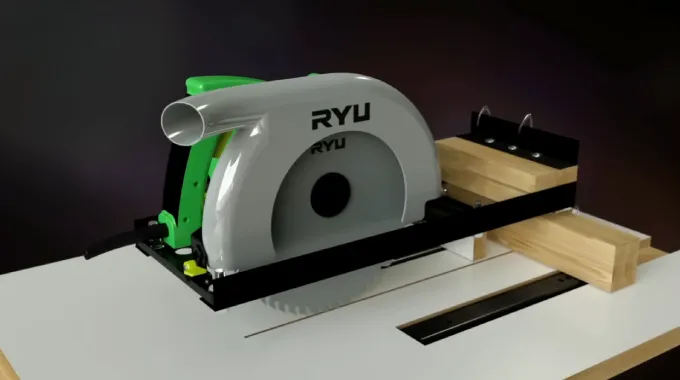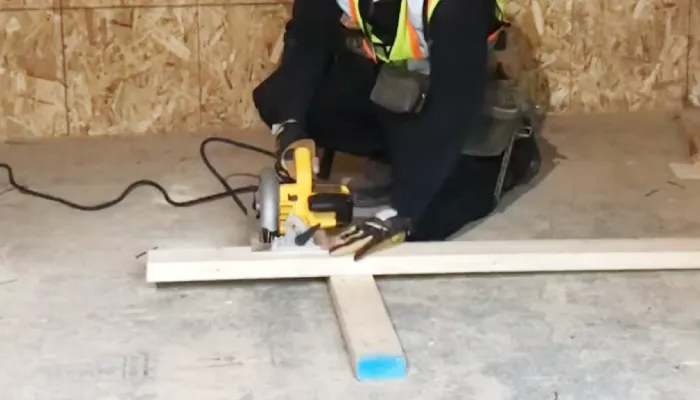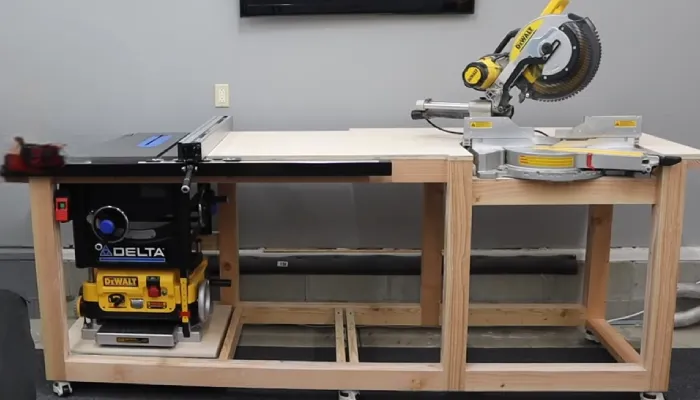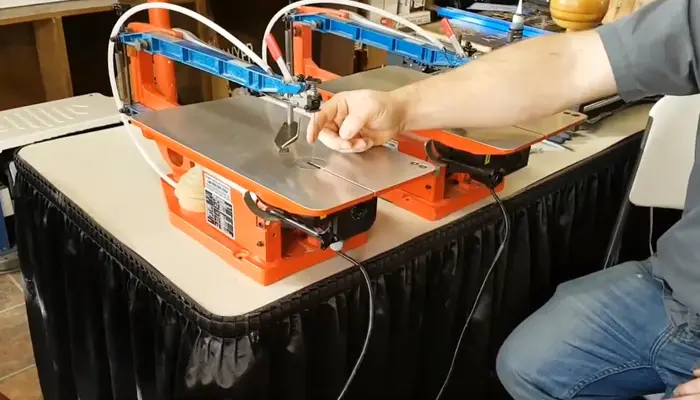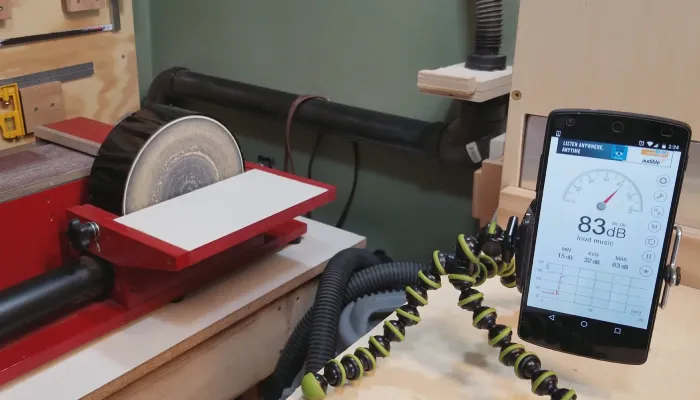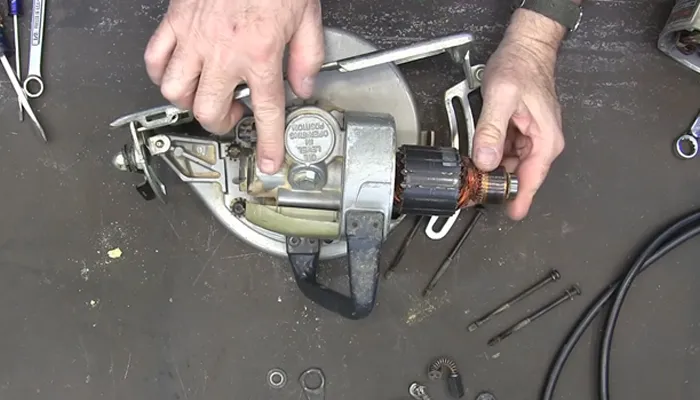Why Is My Circular Saw Blade Not Spinning: 9 Reasons & Solutions
Using a circular saw is a common practice in many woodworking projects, but there are times when you may find that the blade isn’t spinning. This obstacle can cause delays in your woodworking project.
Through my research, I found that there are several reasons why a circular saw blade may not be spinning correctly. One common cause is voltage problems in the power supply, which can cause the motor to struggle and lead to inconsistent power.
Broken gears in the drive train, especially when the circular saw has a gear reduction step, can also result in the blade not spinning.
I will share with you some insights into the most common issues that can cause this problem, as well as the solutions to get your saw up and running again.
Why Is My Circular Saw Blade Not Spinning: Common Reasons with Solutions
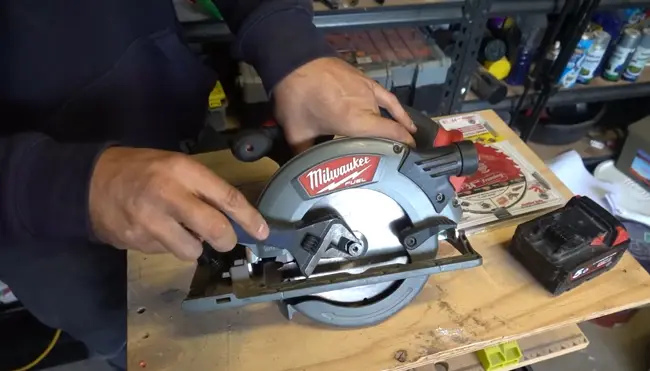
There are several common reasons why your circular saw blade may not be spinning as expected, and each issue requires a specific solution.
- Voltage problems
- Missing washer/Spacer
- Incorrect blade fixation or alignment
- Broken gears in the drive train
- Issues with the trigger mechanism
- Clutch engagement
- Motor overload
- Bearing issues
- Battery issues (Cordless saws)
1. Voltage Problems
A voltage issue in the power supply can cause the motor in the saw to struggle, resulting in the blade not spinning properly. Check your power supply to troubleshoot voltage problems with your circular saw blade not spinning.
Voltage issues can occur when the power supply isn’t stable or when the saw isn’t receiving the appropriate voltage. If the voltage is too low, the motor may struggle to rotate the blade. On the other hand, if the voltage is too high, it can cause excessive heat and damage to the motor.
To ensure a stable power supply, use the appropriate voltage for your saw and make sure you’re using a reliable power source.
If you continue to experience voltage problems, it’s recommended to consult an electrician to check for potential wiring issues affecting the power supply to your handy circular saw.
2. Missing Washer/Spacer
The washer or spacer plays a crucial role in maintaining the proper alignment and spacing between the blade and the motor shaft. If it’s missing, the blade may not rotate smoothly or at all.
To resolve this issue, carefully disassemble the saw and check for the missing washer or spacer. If it’s indeed missing, replace it with the correct size and reinstall it between the blade and the motor. Ensure that all required washers and spacers are in place before reassembling the circular saw.
3. Incorrect Blade Fixation or Alignment
Ensure proper blade fixation and alignment to address the issue of your circular saw blade not spinning. An incorrectly fixed or aligned blade can prevent it from making proper contact with the motor spindle, causing it to stop while the motor continues to run.
To resolve this issue, first, check the blade alignment and ensure it’s correctly centered on the shaft. If the alignment is off, adjust it as necessary to achieve proper alignment before using the circular saw.
This will ensure that the blade spins smoothly and efficiently, allowing you to make accurate cuts and preventing overheating or smoking of the circular saw. Proper blade fixation and alignment are crucial for the optimal functioning of your circular saw and for ensuring your safety during operation.
4. Broken Gears in the Drive Train
A broken gear is a common problem, especially if you have a gear reduction step in the drive system. When the gears are broken, they can impede the rotation of the saw blade, preventing it from spinning your circular saw blade properly.
Examine the gears and any visible damage to the drivetrain of your circular saw if you suspect broken gears. However, handling gears in a power tool can be complex and may require specific tools and expertise.
If you are confident in your mechanical skills, you can consider replacing the broken gears yourself. Unless you’re confident, or if the gears aren’t easily accessible, you should consult an expert or the manufacturer if you’re unsure.
Additionally, if you suspect a problem with a drive belt in your circular saw’s drive system, it’s essential to address it promptly. Replacing a damaged or worn drive belt can also impact the proper spinning of your circular saw blade, so consider consulting a professional or the manufacturer if you need to replace the drive belt.
5. Issues With Trigger Mechanism
The trigger mechanism is responsible for activating the motor and initiating the blade’s rotation. If there are problems with the trigger, such as a faulty switch or worn-out components, it can prevent the blade from spinning.
To resolve this issue, carefully inspect the trigger mechanism for any signs of damage or wear. Look for loose connections, frayed wires, or broken switches in your circular saw. If you detect any issues, they should be repaired or replaced as necessary to ensure proper operation.
Remember to always disconnect the saw from the power source before attempting any repairs on the trigger mechanism.
6. Clutch Engagement
The clutch mechanism protects the saw and the user by disengaging the blade under excessive load or torque. However, if the clutch engages too frequently, it can cause the circular saw blade to stop spinning.
To avoid this issue, you need to be aware of the clutch engagement settings on your saw and adjust them accordingly. Most circular saws have a clutch adjustment knob or switch that allows you to control the sensitivity of the clutch.
7. Motor Overload
Motor overload occurs when the strain on the saw’s motor exceeds its capacity, causing the blade to stop. This can happen when you try to cut through material that’s too thick or dense for the saw’s capabilities, and it may lead to the blade becoming distorted or even breaking.
To avoid motor overload, make sure you choose a blade and saw that is suitable for the specific material you’re working with. If you encounter a thicker or tougher material, consider making multiple passes or using a different tool to prevent excessive strain on the motor and keep your circular saw blade spinning efficiently.
Overloading the saw will result in the motor overheating, potentially causing damage to the saw and affecting its performance. So, always match your tools and blades to the material to ensure safe and efficient cutting.
8. Bearing Issues
When the bearings become worn or damaged, they may not be able to support the weight of the blade properly, causing it to bind or stop spinning altogether. To address this issue, a professional should examine the bearings and determine if they need to be replaced.
Whenever possible, replace damaged bearings promptly to prevent further damage to the saw and to ensure the smooth and efficient operation of the circular saw.
9. Battery Issues (For Cordless Saws)
If you frequently use a cordless circular saw, it’s important to address any battery issues that may be preventing the saw blade from spinning effectively. A weak or dead battery can significantly impact the performance of your saw.
To resolve this issue, start by charging the battery fully before use. Follow the manufacturer’s recommended charging time to ensure optimal battery performance. If the battery is old or no longer holding a charge, it may be time to replace it with a new one.
Investing in a high-quality battery will help maintain the efficiency and power of your cordless circular saw, allowing the blade to spin smoothly and effectively during your cutting tasks.
How to Maintain Your Circular Saw to Ensure Smooth Blade Spinning?
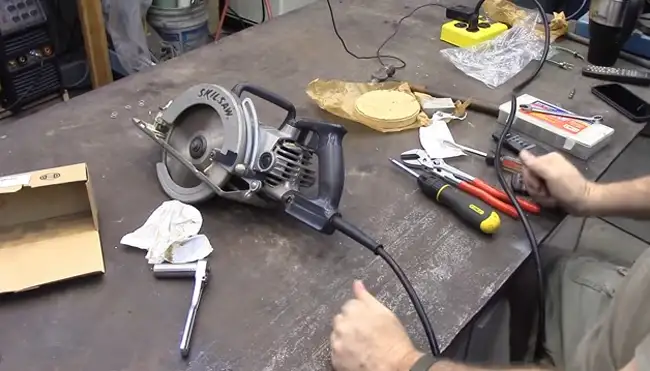
To ensure that your circular saw blade spins smoothly, there are several maintenance tasks you should perform regularly.
1. Inspect the Power Source and Cord
To ensure smooth blade spinning, start by inspecting the power source and cord of your circular saw. Before each use, carefully examine the power cord for any signs of damage, such as cuts, fraying, or exposed wires.
Damaged cords can pose electrical hazards and affect the saw’s performance. If you find any damage, replace or repair the cord before using the saw.
It’s important to ensure that the power source is functioning properly as well. Check if the saw is securely connected to a power outlet or if the battery is charged and installed correctly. Faulty power sources can lead to a lack of power supply, resulting in the blade not spinning.
2. Blade Maintenance
A clean blade reduces the risk of debris buildup, which can cause the blade to stall or become less efficient. After each use, remove any sawdust or debris from the blade using a brush or compressed air. This will help maintain the sharpness and effectiveness of the blade.
Additionally, lubricate the blade regularly to reduce friction and ensure smooth spinning. Apply a thin lubricant layer, such as WD-40, to the blade teeth and rotating parts. This will help prevent rust and prolong the blade’s lifespan, as well as prevent the blade from becoming unbalanced and wobbling during operation.
3. Cleaning the Blade Cage and Guard
To ensure smooth blade spinning, regularly clean the blade cage and guard your circular saw. This will prevent any sawdust or debris from hindering the blade’s rotation.
Accumulated sawdust and debris can obstruct the movement of the blade, leading to inefficiency and potential overheating. Cleaning these areas is essential for maintaining the optimal functioning of your circular saw.
To clean the blade cage and guard, you can use a brush or compressed air. Gently brush or blow away any sawdust or debris that has accumulated in these components. Make sure to clean thoroughly, reaching all the nooks and crannies where debris may be hiding.
If necessary, remove the circular saw blade guard for more thorough cleaning. Regular maintenance of these components is essential to ensure that your circular saw operates smoothly, allowing the blade to spin efficiently and deliver precise cuts.
4. Checking Blade Bevel
To ensure smooth blade spinning and maintain your circular saw, you should regularly check the blade bevel angle. The blade bevel angle refers to the tilt of the blade about the cutting surface.
If the bevel angle isn’t accurate, it can lead to binding and stoppage of the blade during operation. In addition, make sure that your circular saw blades are tightened securely to prevent any issues with the blade spinning.
Check the blade bevel angle by unplugging the saw and turning it off. Then, adjust the bevel angle indicator to the desired setting and use a bevel gauge or a square to verify the accuracy of the angle.
If the angle is off, you can adjust it by loosening the bevel lock and carefully aligning the blade to the correct angle. Once the bevel angle is properly set, you can ensure smooth blade spinning and accurate cuts.
5. Lubrication and Rust Prevention
Regular lubrication and rust prevention are key to ensuring smooth blade spinning and maintaining the performance of your circular saw. By applying lubricant to essential parts such as the blade arbor and motor bearings, you can reduce friction and wear, allowing for seamless blade rotation.
It’s recommended to use a suitable lubricant or a product like WD-40 to protect against rust and corrosion. Additionally, circular saws are prone to rusting due to exposure to moisture. To prevent rust, regular maintenance should include applying a rust-resistant coating to key areas.
6. Cleaning Air Vents and Switches
Dust and debris can accumulate in the air vents, obstructing proper ventilation and leading to overheating. Cleaning the vents is simple, use compressed dry air to blow away any dust buildup.
Additionally, wipe down the exterior of the saw with a damp cloth and mild soap to remove any dirt or grime. Take extra care to avoid allowing any liquid to seep into the saw, as this can cause damage.
Clean the power switch to maintain its proper functioning. Regular maintenance of these components will help keep your circular saw running smoothly and extend its lifespan.
How frequently should you apply lubricant to your circular saw to ensure proper blade spinning?
For proper blade spinning and to maintain the efficiency of your circular saw, it’s advisable to apply lubricant before each use. Focus on lubricating critical components such as the blade guard, spindle, and other moving parts.
This regular pre-use lubrication helps reduce friction, prevents parts from seizing up, and ensures that your circular saw operates smoothly, allowing the blade to spin effectively and deliver precise cuts.
Identify and Resolve Your Circular Saw Issues for Optimal Performance
When you face issues with your circular saw blade not spinning, check the common reasons that I discussed along with the corresponding solutions.
Addressing voltage problems, missing washers, and incorrect blade fixation ensures optimal blade spinning. Repairing broken gears and resolving trigger issues are essential for smooth operation. Adjusting clutch engagement and preventing motor overload maintains efficiency.
Furthermore, bearing problems should be promptly addressed to prevent blade binding. Managing battery issues in cordless saws guarantees consistent performance.
Regular maintenance practices include inspecting the power source, cleaning components, and checking the blade bevel. Lubricating moving parts reduces friction, while rust prevention is crucial. All these steps collectively keep your circular saw in excellent working condition.


